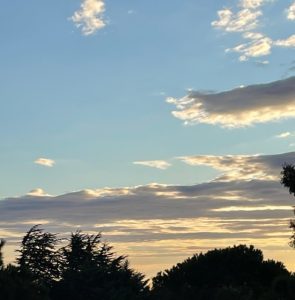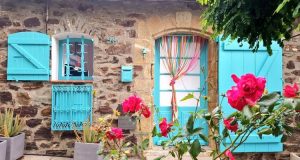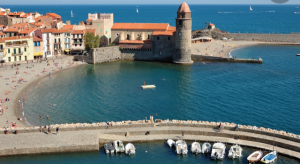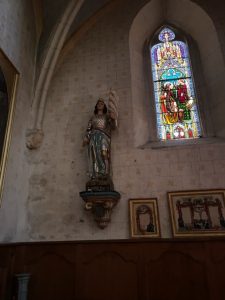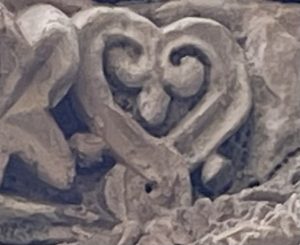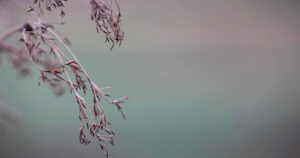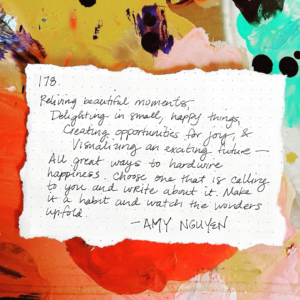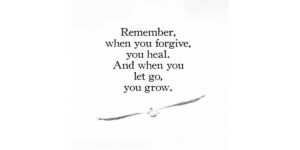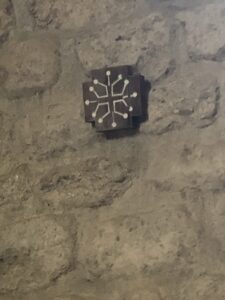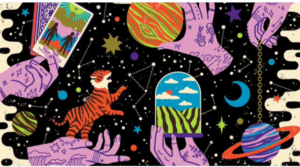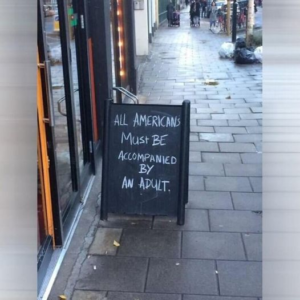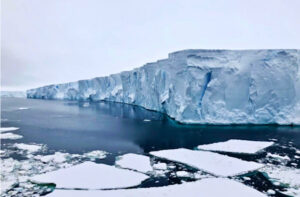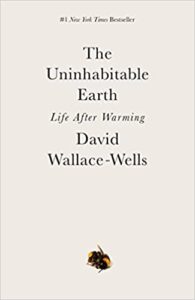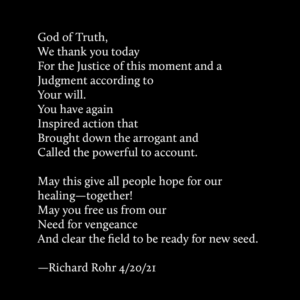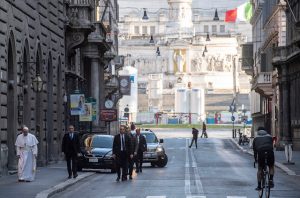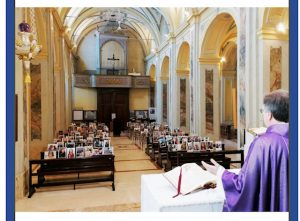Father Richard Rohr
Dayle in Limoux – Day #81
September 25, 2022Gratitude is a quality similar to electricity: it must be produced and discharged and used in order to exist at all. -William Faulkner
My great-grandma’s name, Alma. Alma Evalo Latta. Who gave me a mother’s love when mine was incapable of giving.
The grand parent is able to relinquish center stage and to stand on the sidelines, and thus be in solidarity with those who need their support. Children can feel secure in the presence of their grandparents because, while their parents are still rushing to find their way through life’s journey, grandpa and grandma have hopefully become spacious. They can contain problems, inconsistencies, inconveniences, and contradictions—after a lifetime of practicing and learning.
Grand parents can trust life because they have seen more of it than younger people have, and they can trust death because they are closer to it. Something has told them along the way that who they are now is never the final stage, and this one isn’t either. We need to be close enough to our own death to see it coming and to recognize that death and life are united in an eternal embrace, and one is not the end of the other. Death is what it is. I am a grand father when I am ready to let go. To the grand mother, death is no longer an enemy, but as Saint Francis called it, a “welcome sister.” -Father Richard Rohr
I chose this place to stay in Collioure, on the Mediterranean, because of my grandma who I miss everyday and talk with in my prayers and meditations. When we arrived after a day of back road DRIVING IN FRANCE (WHAT?!),
[A Citroën in France. Bien sûr.]
❗️
[Thank G A I A for co-pilots.]
it was not what was advertised, not so much structures on a beach connected by private platforms,
but na extremely dirty once white tent on rocks with no windows and a bathroom quite far away. We didn’t have what we needed for a cold night of rain and thunderstorms…in a tent. <sigh> Alma is camping, not ‘glamping.’ So we left and went searching for a new place, on a Saturday. Pas bon. Looked at a Templar hotel, with a window opened to access pigeons in a dark, damp, alley. No merci. Finally, we landed, Grand Hotel Du Golfe, on the Gulf of Lion. Tres bon.
The colours of Collioure, a small village, home to about 2,800 people, in the south of France. It’s just over 2 hours to Barcelona.
[Image: whereistara]
Matisse, Soutine, Gauguin, Picasso, Miró. All artists who made pilgrimage to Colloure for the colours…
Picasso
Matisse
A perfect good morning in Collioure. ☀️
Qu’est-ce tu as fait aujourd’hui?
What did I do today? I explored Southern France with two of my most favorite people on the planet, Annie Glenn and Michael Gillette. Radical Grace. Thanks be to you, dear Gaia. (I miss you William Henry.)
Aujourd’hui?
Exploring the ruins of Puilaurens and Montsegur, traveling the back ancient roads of Landguedoc/Occitanie. ღ
Father Richard Rohr reminds us today,
Saint Thérèse of Lisieux (1873–1897) called a simple, childlike path her “little way.” It is a spirituality of imperfection. In a letter to priest Adolphe Roulland (1870–1934), she writes: “Perfection seems simple to me, I see it is sufficient to recognize one’s nothingness and to abandon oneself as a child into G A I A ‘s arms.” Perfection is, in fact, our ability to include, forgive, and accept our imperfection. As I’ve often said, we grow spiritually much more by doing it wrong than by doing it right. That might just be the central lesson of how spiritual growth happens, yet nothing in us wants to believe it.
If there is such a thing as human perfection, it seems to emerge precisely from how we handle the imperfection that is everywhere, especially in ourselves. A “perfect” person ends up being one who can consciously forgive and include imperfection rather than the ones who think they are totally above and beyond imperfection. It becomes rather obvious once we say it out loud.
F
O
R
G
I
V
E
N
E
S
S
Our greatest gift to give. jai
Finding light’s colour.
[Collioure]
À bientôt.
❀
Dayle in Limoux – Day #75
September 18, 2022by Suleika Jaouad
‘…but I’m still yearning. It’s different now, in that it’s not specific things, just the word: more. That’s the bittersweetness of being granted your wishes, then facing the prospect of losing them. I love my life—my family, my husband, my sweet new dog, my friends, my home, my garden, my work, and this beloved community—and I want to be able to enjoy that life, today and tomorrow and for many years to come.
But with this illness and all the treatment side effects, I can’t rely on my body from hour to hour, much less day to day or week to week, which makes planning or making commitments so difficult. It’s strange to have a sense of urgency to make and do and see, but to also have a body that often just can’t. It’s a particular kind of entrapment.
So here at the beginning of fall, instead of embarking on some grand adventure, I’m rejoicing in the moments where I can enjoy a small one. One day last week, while out at my farmhouse, I woke up feeling… well, feeling like I hadn’t just consumed a dose of rat poison. I have two electric bikes, and that afternoon, my friend Kristen and I hopped on and started speeding down the winding country roads, past babbling brooks, under covered bridges, up into the hills. After awhile, we stopped at a plant nursery with a little outdoor bar and lounge and had cocktails—something I hadn’t done in a very long time. By the time we left, the sun was setting, and I felt almost giddy. That afternoon, I’d had more.
[Alet-les-Bains in Languedoc, France.]
From Fr Richard Rohr, Center for Action and Contemplation.
Old age, as such, is almost a complete changing of gears and engines from the first half of our lives, and does not happen without many slow realizations, inner calmings, lots of inner resistance and denials, and eventual surrenders. All of them by God’s grace work with our ever-deepening sense of what we really desire and who we really are.
Reality, fate, destiny, providence, and tragedy are slow but insistent teachers. The horizon of old age seems to be a plan that God has prepared as inevitable and part of the necessary school of life. What is gratuitously given is also gratuitously taken away, just as Job slowly came to accept.
If we are to speak of a spirituality of ripening, we need to recognize that it is always characterized by an increasing tolerance for ambiguity, a growing sense of subtlety, an ever-larger ability to include and allow, and a capacity to live with contradictions and even to love them! I cannot imagine any other way of coming to those broad horizons except through many trials, unsolvable paradoxes, and errors in trying to resolve them.
The ripening of mind and heart is most basically a capacity for nondual consciousness and contemplation. So my guidance is a simple reminder to recall what we will be forced to learn by necessity and under pressure anyway—the open-ended way of allowing and the deep meaning that some call faith. To live in trustful faith is to ripen; it is almost that simple.
There she is. Johanne. Joan of Arc.
At Église Saint André in Alet-les-Bains.
L
O
V
E
It finds us.
Bonne Nuit.
ღ
Monday, May 2, 2022
May 2, 2022Today, sources with the United Nations Office of the High Commissioner for Human Rights are reporting 3,000 civilians have died in Ukraine. Understandably, “the real toll is likely to be considerably higher, citing access difficulties and ongoing corroboration efforts.”
‘The metaphysical basis, the stable core must be with Divine Union or it always bounces bock to the
u
n
s
t
a
b
l
e
core of human behavior.’ [R. Rohr] Indeed.
‘Everything in our lives is another lesson in the one continual school of conscious loving.’
And we fail. Humanity fails again and again and again…
Father Richard Rohr at the Center for Action and Contemplation:
“To be clear, it is inconceivable that a true [believer of any faith] would be racist, anti-Semitic, xenophobic, homophobic, or bigoted toward any group or individual, especially toward the poor and vulnerable, which seems to be an acceptable American prejudice. To end the cycle of violence, our actions must flow from our authentic identity as Love.
One of the reasons I founded the Center for Action and Contemplation was to give activists some grounding in spirituality so they could continue working for social change, but from a stance much different than vengeance, ideology, or willpower pressing against willpower. Most activists I knew loved Gandhi’s and Martin Luther King, Jr.’s teachings on nonviolence. But it became clear to me that many of them had only an intellectual appreciation rather than a participation in the much deeper mystery. The ego was still in charge, and I often saw people creating victims of others who were not like them. It was still a power game, not the science of love that Jesus taught us.
When we begin by connecting with our inner experience of communion rather than separation, our actions can become pure, clear, and firm. This kind of action, rooted in one’s True Self, comes from a deeper knowing of what is real, good, true, and beautiful, beyond labels and dualistic judgments of right or wrong. From this place, our energy is positive and has the most potential to create change for the good.”
‘It is normally three steps forward, two steps backwards, and, as Lady Julian of Norwich says, “Both are the mercy of God.”
(I wish I could see the mercy in the backward momentum of this Universal equation.)
Saturday, January 22, 2022
January 22, 2022The Earth is everywhere. You may be used to thinking of the Earth as only the ground beneath your feet. But the water, the sea, the sky, and everything around us comes from the Earth. Everything outside us and everything inside us comes from the Earth.
—Thich Nhat Hanh
[Image: Center for Action and Contemplation]
“Thank you” is a simple phrase, but one that carries a lot of meaning. So many people act in ways big and small each day that help others for no expected monetary or other return other than the satisfaction that comes from the act itself.
Inn times of struggle, sadness, and fear, let us all remember the helpers in the world, and try to be helpers to others. Let us be kind and generous. And let us not take all that is good out there for granted. -Dan Rather
For our ancestors.
Mitákuye Oyás’iŋ
“The world is not a problem to be solved; it is a living being to which we belong. The world is part of our own self and we are a part of its suffering wholeness.”
—Llewellyn Vaughan-Lee
From Father Richard Rohr:
“Our very suffering now, our condensed presence on this common nest that we have largely fouled, will soon be the one thing that we finally share in common. It might well be the one thing that will bring us together politically and religiously. The earth and its life systems, on which we all entirely depend might soon become the very things that will convert us to a simple lifestyle, to necessary community, and to an inherent and universal sense of reverence for the Holy. We all breathe the same air and drink the same water. There are no Jewish, Christian, or Muslim versions of these universal elements. All water is “holy water” even before the benefit of a priest’s waved hand. It is always and everywhere two parts hydrogen and one part oxygen, and voilà—we have the absolute miracle of liquid water, absolutely necessary for all that lives.
This earth indeed is the very Body of God, and it is from this body that we are born, live, suffer, and resurrect to eternal life. Either all is God’s Great Project, or we may rightly wonder whether anything is.”
And…
Francis of Assisi called animals “Sister” and “Brother” and viewed humans as one part of a wider family of creation. Franciscan writers Ilia Delio, Keith Douglass Warner, and Pamela Wood recommend adapting a historic Christian practice of “examination of conscience” to focus on how we have harmed or helped our relationships with the Earth:
- Do I seek to eliminate from the world whatever keeps all creatures from their full development intended by their Creator: pollution, greed, overconsumption, loss of habitat, disease, war, extinction of species, oppressive laws and structures? . . .
- Have I encouraged others to take care for creation seriously? . . .
Sunday, January 16th, 2022
January 16, 2022Marianne Williamson:
Not every lesson feels fun while it’s happening, and at times I have resisted growth fiercely. But I remain open today to the miracle of transformation. I know that as I move forward into a new realm of being, Love itself will aid me in my progress. Spirit will erase the patterns of fear that have sabotaged my past.
“Freedom without consequences is a myth.
Our actions always have consequences.
The question is: who will bear them?” -Seth Godin
From https://www.suleikajaouad.com newsletter this week.
Suleika, your name is on my alter as you continue to ease back into health. February v i b e s strong. Only love and healing and wholeness. -dayle
“When you’re suffering—enduring some kind of rage or heartbreak, disappointment or plain human idiocy—it can feel like you’re alone, like you’re the only person who’s struggling this way. Often, the impulse in those moments is not to share or create but to hide.”
-Suleika Jaouad
Diving deeply into a dynamic unity, Father Richard Rohr writes:
In the early Christian era, only some few Eastern Fathers (such as Origen of Alexandria and Maximus the Confessor) cared to notice that the Christ was clearly something older, larger, and different than Jesus himself. They mystically saw that Jesus is the union of human and divine in space and time, and the Christ is the eternal union of matter and Spirit beyond time. But the later centuries tended to lose this mystical element in favor of dualistic Christianity. We lost our foundational paradigm for connecting all opposites.
Since we could not overcome the split between the spiritual and the material within ourselves, how could we then possibly overcome it for the rest of creation?
The polluted earth, extinct and endangered species, tortured animals, nonstop wars, and constant religious conflicts have been the result. Yet Jesus the Christ has still planted within creation a cosmic hope, and we cannot help but see it in so many unexplainable and wonderful events and people.
For more and more people, union with the divine is first experienced through “the Universal Christ”—in nature, in moments of pure love, silence, inner or outer music, with animals, or a primal sense of awe.
Our encounter with the eternal Christ mystery started about 13.8 billion years ago in an event we now call the “Big Bang.” God has overflowed into visible Reality and revealed God’s self in trilobites, giant flightless birds, jellyfish, pterodactyls, and thousands of species that humans have never once seen. But God did. And that was already more than enough meaning and glory.
From journalist and former CBS news anchor Dan Rather today:
Steady is about taking the world as it comes, trying to control what you can but recognizing much is beyond your ability to shape. It is about joining with others to leverage the power of collective action. It is about caring for yourself when you need to regain your footing. It’s about understanding that others have struggled in the face of injustice and despair. Steady is about recognizing that progress is possible, even when it feels ungraspable. It is also about having the humility to understand that joy can be fleeting, so you need to find it and hold on to it when you can.
I don’t know what the next year holds in store, for me, for you, or for our country and our planet. I hope it is one of greater justice, peace, and health. I know that it will undoubtedly be one of challenges, in ways we can predict, and in ways that are unknowable.
Emerson:
God offers to every mind its choice between truth and repose. Take which you please…you can never have both. […] There is no history. There is only biography.
“Caution is like a disease, it kills ideas. Be daring. And caution will disappear.” -Yoko
Wednesday, 1.12.22
January 12, 2022Father Richard Rohr
Center for Action and Contemplation
Once we allow the entire universe to become that alive and dynamic, we are living in an enchanted world. Nothing is meaningless; nothing is able to be dismissed. It’s all whirling with the same beauty, the same radiance. In fact, if I had to name the Big Bang in my language, I’d call it the Great Radiance. About 13.8 billion years ago, the inner radiance of God started radiating into forms. All these billions of years later, we are the continuation of that radiance in our small segment of time on this Earth. We can either allow it and let the Infinite Flow flow through us, or we can deny it, which is really what it means not to believe.
This is not something I can prove to anyone. This is nothing I can make logical or rational. It’s only experiential, and it’s only known in the mystery of love when we surrender ourselves to it, when we grant the other inherent dignity and voice—the plant, the animal, the tree, the sky, Brother Sun and Sister Moon as my Father Francis of Assisi put it.
Beguines, the ‘world’s oldest women’s movement…’
NYTIMES
Some historians believe they banded together after losing their men to the Crusades, which left behind mainly criminals and louts — beguines were not confined to the cloister. Many ministered to the poor and sick outside their walls. Lifelong celibacy was not required either. They could leave the order and marry (but not return).
Traces of these remarkable women and their idiosyncratic spiritual ways can be found today in the urban islands of quietness they once called home. Known as beguinages or begijnhofs, several dozen of these compounds are still intact (to varying degrees) from England to Germany. Ten years ago Unesco declared a select group as World Heritage Sites. No country has more beguinages (29) than Belgium, and a trip to inspect a few in three cities seemed like a pleasant way to spend a spring day, especially given the ease with which one moves by train in that convenient nation.
In its modesty, this beguinage is reminiscent of a poorly endowed college at Oxford. The bourgeois values of peace and tidiness govern all beguinages, elements that look forward to the airy clarity of the Enlightenment rather than back to the Gothic sublime of the Middle Ages.
These were “independent women who defined for themselves what it meant to live according to gospel values. Beguines were not nuns. They used their sources of income to purchase homes near the chapel or parish church where they gathered together for prayer. They emerged in the midst of a so-called first renaissance when European society was transforming itself from a narrowly defined structure of a great many peasants.
Several factors propelled this renaissance and supported the emergence of the beguines, including the Crusades and courtly culture, emerging cities and their fledging universities, a new money-based economy, the growth of lay spirituality and the cult of the Virgin Mary, as well as new monastic orders.
Additionally, there was a phenomenon called vita apostolic, which means the ‘apostolic life’ or ‘the life of an apostle.’ Beguines were a powerful expression of the vita apostolica.
Leading profound simplicity, beguines pooled their resources in order to serve the sick and destitute by building and operating infirmaries and almshouses.
- Hildegard of Bingen
- Heloise
- Marguerite d’Oingt
- Gertrude of Helfta
And many women became beguines as a result of their newfound literacy.
A heretic is a person who allegedly corrupts established faith doctrine, often by selecting a limited set of beliefs and denying the other parts of orthodox teaching.
It was a highly charged political environment in the medieval world.In a society strongly defined by each person’s specific place (such as belonging to the guilds or merchants, to aristocratic or religious classes or the the peasantry), beguines were violating their ‘God-assigned place’ in order to serve the gospel.
Beguines were under church investigation at different ties and in different parts of Europe for their spiritual independence.
While most beguines were quite orthodox, there were some religious laywomen who did join the Cathars, the Free Spirits, The Spiritual Franciscans, and other suspected heretical movements.
Most challenges of heresy, however, were politically motivated. When beguines challenged inept clergy, they made priests and bishops angry. When beguines condemned the red and corruption within the church, they made the church hierarchy angry. When beguines denounced the cruelty done to innocent laypeople through interdict, they made the popes angry. Beguine preaching would always make some men in power angry.
Beguines showed great strength and persistence and collaborated with fellow seekers, tolerated diversity, and raised difficult questions; they exercised both communal and personal wisdom and freedom to follow God as they felt called.
The story of the beguines affairs that women have contributed far more to spirituality and culture than history books have traditionally acknowledged. Their voices proclaim a divine presence that years for relationship with each of us.
These medieval women offer us hope and a fresh path: to think creatively, to collaborate to achieve change, and to live with prophetic courage.”
“A movement, rather than an order, there was no single style or pattern of beguine life.
While reacting against the wealth and ostentation of secular society, the beguines did not see poverty as an end in itself, rather they encouraged the development of the virtues of charity, humility and companionship.
Beguines worked in hospitals, visited the sick in their homes and established infirmaries.
As the church became increasingly paranoid concerning the presence of heterodox teachings, and brutal it its attempt to eradicate those it conceived of a threat, beguines, along with Jews, witches and various other sects, found themselves vulnerable and subject to frequent accusations of heresy, with often terrible consequences.”
~
The French mystic Marguerite Porete was burned at the stake in Paris in 1310, after a year and a half of imprisonment. Her crime was to repeatedly refuse to appear before the court of the inquisitorial commission to answer charges relating to her book, The Mirror of Simple Souls. During her trial, she refused to swear the oath required of her by the inquisitor’s office and she showed no remorse for having violated an injunction to withdraw her book from circulation after it had been publicly burned several years previously. Many who witnessed her execution were said to be moved to tears by her piety.
Little is known about Porete, apart from the record of her trial and what can be gleaned from her writings. It seems likely that she was associated with the beguines, a women’s religious movement which spread across northern Europe during the 13th and 14th centuries. Although the beguines devoted themselves to charity, chastity and good works, they took no religious vows and their lifestyles varied greatly, from solitary itinerants (of which Porete was probably one) to enclosed communities. The beguines were part of an era of vigorous spiritual flourishing during the Middle Ages. They were condemned by the Council of Vienne (1311-1312), which also condemned the Free Spirit Movement with which they were sometimes (and probably erroneously) identified. Although the beguine movement declined dramatically in the 15th century, some beguine communities survived until the early 20th century. The beguinage in Leuven in Belgium is a Unesco world heritage site, and to wander through its quiet cobbled roads and enclosed gardens is to feel a poignant sense of the lost history of women’s lives.
~
And this, by Allysha Lavino…recommend highly.
My review from 2020 for Amazon, Trust the Magic:
What did you see today?
What did you learn today?
What did you love today? (p.79)
Henry Lincoln chose to See, and now, Allysha has chosen to See with the eyes and wisdom of the Divine Feminine in The Heretic. Having both discovered their place in the universal pattern, Allysha invites us through beautiful and brilliant storytelling to find our own place through sacred geometry while meeting the Good People, the ancient Cathars, in Southern France. Reading The Heretic, I had the remarkable context of a Sacred Mystery Tour with Allysha and her husband, Mark, co-led by Sir Henry, to visit the sites revealed in the Languedoc region of Southern France. My hope is that if you’ve landed in this virtual space—”nothing is done par hazard” (p. xv)—either directed by the Divine Feminine or a passionate friend, you, too, will be called to physically explore the ruins and profound spiritual places Allysha excavates in the pages of The Heretic. If not, this book will be your experience. Allysha has magically captured through character and compassion the Wisdom resting beneath all things, the dualism of good and evil. During this time of pandemic and global social sadness, Allysha reminds us through her ancient research and inspired writing that suffering cannot destroy us, beauty is in everything, “though the world around us was filled with the shear chaos of the unknown” (p. 217). She gently encourages us in her story to “trust the magic,” as she gathers what Emily Dickinson called the fruits of the spirit: patience, kindness, gentleness and self-control. It is Lily’s discoveries along with her young ethereal guides at the old hotel in Alet-les-Bains who encourage us to charge the awakening. I didn’t want this book to end—gratitude to Gaia it is a trilogy! Allysha, “thank you for your wisdom…your joy…your peace…your guidance…your strength…your love (pp. 265-266). As Henry writes in his Forward, “The world has been preparing Allysha for this task for years, unbeknownst to either of us.” Baphomet, friends…the path awaits.
Author Beatrice Bruteau [1930–2014]: “We need a new theology of the cosmos, one that is grounded in the best science of our day, so that all the world turns sacred again.”
-Dayle Ohlau
Final days. #2022
December 30, 2021‘I regret nothing.’ -Edith Piaf
‘I’ve learned a great deal this year. What kind of year did you have? No matter how many challenges you’ve had, no matter what pain you’ve endured, did you do your very best? Then have no regrets.’ -A. Stoddard
As a collective we should have so many, and we can do so much better. We must. -dayle
Brian McLaren from the Center of Action and Contemplation:
“Something beautiful lies ‘unveiled’ on the other side of complexity and perplexity.”
Gatekeepers have long built razor-wire fences around us with
- beliefs
- rules
- policies
- controversies
- budgets
- programs
- activities
- rituals
- offerings
- inquisitions
Spirituality, though, is available to everyone, like wind, rain, and sun. [Brian McLaren] This is what we harness and share, and protect. “In politics, we’ve been studying war for centuries. We must now study how to crate the conditions for deep and lasting peace. We must now cherish life on earth and engage with it by focusing our best energies on learning to love neighbor, self, earth, and God…Gaia…who is Love.”
LATimes
What LA astronomers and diviners have in store for you in 2022.
-Deborah Netburn, staff writer
‘Spend time dreaming about the world in which you want to live…get specific about what real-life steps you can take to make it a reality. Ask, what does it mean to you to release the Earth, working with others to help the land rest more?’
Full piece [paywall]:
‘These are scary, uncertain times. The pandemic has thrown our lives into chaos once again. Global warming has upended the predictable flow of the seasons. The political climate is divisive and volatile. With all this anxiety swirling around us, is it any wonder that tarot readers, astrologers and other divinatory practitioners say they’ve never been busier? All of us want to know what will happen next.
From the Oracle at Delphi to the Yoruba practitioners of Ifá, there are myriad ways to approach divination and myriad reasons for wanting to see into the future. These tools can be seen as a framework to make sense of the events in our lives. Through this lens, divinatory practices encourage believers to pay attention to the patterns in their lives and the cycles of nature and to move through time with intention.
Los Angeles is among the most spiritually diverse cities in the world; we live alongside thousands of divinatory practitioners from a wide range of traditions — many of whom have devoted their lives to the study of ancient practices that go back thousands of years. As we enter a new calendar year, I asked a handful of them what archetypal energies they expect we’ll encounter over the next 12 months and how we might prepare.’
[Posted on twitter, as seen outside a pub in Europe.]
Eric Holthaus, The Phoenix:
“Any time a climate movie breaks through, it’s worthy of celebration. But this isn’t an ordinary climate movie. #DontLookUp![]() is special.”
is special.”
In the last days of 2021, a year in which Texas froze and the freakin’ ocean caught fire, the number one movie in the world on Netflix is a star-studded climate movie that’s not about climate.
Let me be super clear: Any time climate breaks through, it’s worthy of celebration. But this isn’t an ordinary climate movie. Don’t Look Up is special.
Watching it last night for the first time, I was legitimately blown away by how much I felt like I could relate to the main plot — well-meaning scientists being ignored because their message wasn’t pleasant or profitable. I was scared to watch it because I was worried it would make me feel even more depressed than I already do about being a climate communicator during these decades of climate delay, but it’s just the opposite. This is the climate movie I was waiting for.
“The reason I think Don’t Look Up works so well is because the film’s creators did their homework. There are so many Easter Eggs thrown in throughout that it’s like a love letter to climate activists. There is a massive, waiting audience for authentic climate movies like this that speak to the deep, existential anxiety of being alive at this profoundly terrifying moment in history. We know how to solve the climate emergency — stop burning fossil fuels, build up a circular, caring society, and shift political power so that nothing like it ever happens again — and yet our leaders are staring us straight in the face and saying no.
Director Adam McKay wrote that his own climate anxiety after reading David Wallace-Wells’ The Uninhabitable Earth helped inspire the film, and screenplay co-writer David Sirota wrote that empowering the climate movement was a primary goal of the film.
I reached out to McKay and Sirota, and they both confirmed this hunch I had that the movie wasn’t just a political satire, it was a gift for battle-weary activists after several long, hard years of struggle. “We literally made Don’t Look Up for the climate community,” McKay told me.
When I asked Sirota about the movie’s lack of a preachy, prescriptive call-to-action takeaways at the end, he said that was intentional.
“We want it to be a clarion call for the movement,” Sirota said, “But also respect that the movement should decide its tactics.”
The movie isn’t perfect. There’s too much of a focus on the United States, and there’s a valid criticism that seeking action from corrupt politicians during a time of crisis is counterproductive. We know that climate action at the scale and scope we need will only come from collective movements.
But that’s exactly our job now — tell more climate stories that build on this one.
This isn’t a movie that could exist without the decades of failures that have happened so far. But it’s also a movie that finally FINALLY acknowledges that the lynchpin to taking action on climate isn’t about data or carbon or graphs, it’s about finding our shared humanity.
That part is working:
Authentic climate action is way easier than shooting nukes at a comet — it’s treating each other and the Earth better. It’s listening. It’s building systems of power to replace the systems that have been built to kill us.
It’s up to us, the climate movement, to redirect the energy that Don’t Look Up gives us.”
David Wallace-Wells:
“Globally, 250 million people live within three feet of high tide lines. Ten feet of sea level rise would be a world-bending catastrophe. It’s not only goodbye Miami, but goodbye to virtually every low-lying coastal city in the world.”
“Thwaites Glacier is the size of Florida. It is the cork in the bottle of the entire West Antarctic ice sheet, which contains enough ice to raise sea levels by 10 feet.” The great Jeff Goodell on the scary signs from the “Doomsday” glacier.
Rolling Stone
by Jeff Goodall
‘The Fuse Has Been Blown,’ and the Doomsday Glacier Is Coming for Us All
New data suggests a massive collapse of the ice shelf in as little as five years. “We are dealing with an event that no human has ever witnessed,” says one scientist. “We have no analog for this”
“Given the ongoing war for American democracy and the deadly toll of the Covid pandemic, the loss of an ice shelf on a far-away continent populated by penguins might not seem to be big news. But in fact, the West Antarctic ice sheet is one of the most important tipping points in the Earth’s climate system. If Thwaites Glacier collapses, it opens the door for the rest of the West Antarctic ice sheet to slide into the sea. Globally, 250 million people live within three feet of high tide lines. Ten feet of sea level rise would be a world-bending catastrophe. It’s not only goodbye Miami, but goodbye to virtually every low-lying coastal city in the world.”
Power in disorder (Joan Didion). Let’s reclaim it now.
Order, disorder, reorder (Father Richard Rohr).
Pandemic life.
Climate Emergency.
Pari Center, Italy.
700,000.
October 2, 2021“We already know this law of compassion, because it is written on our hearts. We contradict our own good common sense when we seek ritual purity or any kind of moral superiority instead of loving who/what is right in front of us.”
-Father Richard Rohr, Center for Action & Contemplation
♡
🖤
April 21, 2021Father Richard Rohr wrote this prayer yesterday after Minneapolis police officer Derek Chauvin was found guilty of the murder of George Floyd. Richard and the Daily Meditations editorial team invite you to pray these words, along with your own, as your contemplative practice today.
Center for Action and Contemplation
Albuquerque, New Mexico
‘The beauty of ambiguity…’
May 11, 2020My interests lie within the beauty of ambiguity held within painting that pursues a sacred direction within the realm of Christology.
Daniel Bonnell is known throughout the United States, England and Israel as one of the few noted sacred painters of the 21st Century. His art is found in private collections, cathedrals and churches around the world. He holds a B.F.A. from the Atlanta College of Art and an M.F.A. from the Savannah College of Art and Design. His major online gallery is found at https://bonnellart.com.
Why is Julian of Norwich so appealing today? I think because she is totally vulnerable and transparently honest, without any guile. She is “homely”; in medieval terms, that means down-to-earth, familiar, and easily accessible. She is keenly aware of her spiritual brokenness and longs to be healed. So do we. She experiences great suffering of body, mind, and soul.
So do we.
She has moments of doubt. So do we. She seeks answers to age-old questions. So do we. Then, at a critical turning point in her revelations, she is overwhelmed by joy and “gramercy” (great thanks) for the graces she is receiving. We, too, are suddenly granted graces and filled to overflowing with gratitude. Sometimes, we even experience our own divine revelations.
-Father Richard Rohr, Center for Action & Contemplation
Good Friday
April 10, 2020In Jerusalem yesterday, a priest peers from the door of the Church of the Holy Sepulchre, where Christians believe Jesus was buried. Photo: Ariel Schalit/AP
Father Richard Rohr, Center for Action & Contemplation:
‘It is true that you are going to die, and yet “I am certain of this, neither death nor life, nothing that exists, nothing still to come, not any power, not any height nor depth, nor any created thing can ever come between us and the love of God” (Romans 8:38-39).
On Good Friday, we lament Jesus’ death while living in hope that death does not have the last word on our destiny. We are born with a longing, desire, and deep hope that this thing called life could somehow last forever. It is a premonition from something eternal that is already within us. Some would call it the soul. Christians would call it the indwelling presence of God. It is God within us that makes us desire and seek God.
Yes, we are going to die, but we have already been given a kind of inner guarantee and promise right now that death is not final—and it takes the form of love. Deep in the heart and psyche, love, both human and divine, connotes something eternal and gratuitous, and it does so in a deeply mysterious and compelling way. We are seeing this now in simple acts of love in this time of crisis, such as people volunteering to make masks and deliver food, or people cheering hospital workers arriving for their shift. Isn’t it amazing how a small act of love or gratitude can imprint a deeper knowing on our soul?
The crucifixion of Jesus is the preeminent example of God’s love reaching out to us. It is at the same moment the worst and best thing in human history. The Franciscans, led by John Duns Scotus (1266-1308), even claimed that instead of a “necessary sacrifice,” the cross was a freely chosen revelation of Total Love on God’s part.
In so doing, they reversed the engines of almost all world religion up to that point, which assumed that we had to spill blood to get to a distant and demanding God.
On the cross, the Franciscans believed, God was “spilling blood” to reach out to us! This is a sea change in consciousness. The cross, instead of being a transaction, was seen as a dramatic demonstration of God’s outpouring love, meant to utterly shock the heart and turn it back toward trust and love of the Creator.
I believe that the cross is an image for our own time, and every time: we are invited to gaze upon the image of the crucified Jesus to soften our hearts toward all suffering.
Amidst the devastating spread of COVID-19, the cross beckons us to what we would call “grief work,” holding the mystery of pain, looking right at it, and learning from it. With softened hearts, God leads us to an uncanny and newfound compassion and understanding.’
Pregare.
March 20, 2020Pope Francis:
‘Let us pray together for doctors, hospital staff, and volunteers who are giving their own lives to save others. And for civil leaders, for those who have to make decisions at this time. All these people are the pillars defending us in this crisis.’
In Italy, one priest asks for photos from his parishioners to place them in his sanctuary as he prays for them, everyone, during this time of pandemic.
From Hailey, Idaho’s Rev. Lea Colvill: ‘This Italian priest demonstrates how we see with our hearts.’
Father Richard Rohr, at the Center for Action & Contemplation in New Mexico:
‘As we grow in the spiritual life, our life will become increasingly centered. Only a few things will really matter. Because of the coronavirus outbreak, I see a lot of people right now thinking this way. There’s a sense that we’re all in this together—every continent, country, class, religion, race, age, or gender. We’re all subject to this crisis. Suffering has an ability to pull you into oneness.’
But in these dancing tears,
what is often withheld can be found:
our strength.
Rilke
“Wait and work with hope inside of the darkness.”
December 6, 2019‘We must all hope and work to eliminate suffering, especially in many of the great social issues of our time. We work to eliminate world hunger. We strive to stop wasting the earth’s resources. We peacefully fight to end violence. We don’t ignore or capitulate to suffering, yet we must allow it to transform us and the world. Suffering often shapes and teaches us and precedes most significant resurrections.
The darkness of this world will never totally go away. I’ve lived long enough and offered spiritual direction enough to know that darkness isn’t going to disappear, but that, as John’s Gospel says, “the light shines on inside of the darkness, and the darkness will not overcome it” (1:5).’
-Fr. Richard Rohr
Center for Action & Contemplation
[Image credit: Helen Keller, no. 8 (detail), 1904, Whitman Studio, The Helen Keller Foundation; colorist, Jared Enos.]
Redemption.
February 7, 2019Instead of covering up a previous admission for his despicable college behavior to save his governor seat, the governor of Virginia could have apologized again, after his first direct apologetic response, and then in public forum ask that he be forgiven; then, in turn, allow him to use this time, his platform, for redemption and cultural change for his community, state, and country. Invite people of color to establish ongoing state committees to address race and racial behaviors/profiling.
How many of us have looked at our yearbooks from 35 years prior, or remember the pictures we took part? It is not an excuse. It is reality. The Governor’s fundamental mistake is he did not own his behavior, instead tried to cover up an act he admitted to committing. He wasted and confused a powerful moment of redemption for change.
Now other photos similar in racist behavior are surfacing as well as self-admissions about racial hate/profiling [actor Liam Neeson].
Instead of resigning or terminating positions, can we instead use this time to dialogue on national and community platforms about misguided behaviors, complicit biases, needed changes in language and behavior? Those knowingly guilty of past racial behaviors and rhetoric could add to a culture of redemption and change. This is not a political issue. This is a humanitarian issue. It is invasive and prolific and dangerous. And it continues. We can’t resign this away. Retribution falls to all of us who are complicit in our ignorance and our response.
Blackface is still practiced. One personal anecdote. On a small mid-western liberal arts college campus in 2018 a young student at my daughter’s university dressed in blackface and attended a public event. She later was deactivated from her sorority and forbidden to participate in her graduation ceremony. This is only one event. And it was just last year.
Honesty, dialogue, and redemption. This won’t change until we do.
Father Richard Rohr:
We need to draw close to the pain of the world and allow it to radically change perspective (not push it away).
Embrace imperfection and injustices to allow these situations to change from the inside out.
Reality has a cruciform pattern.
Reality is filled with contradictions.
We have an injury on the body politic in this country, an injury that white Americans inflicted on people of color for generations through oppression and murder. And it continues.
We can not walk away from this…’resign’ it. We must embrace it to end it.
Again,
embrace imperfection and injustices to allow these situations to change from the inside out.
AP
“Racist history of blackface began in the 1830’s.”
A racist photo from a 1984 yearbook threatens to end Virginia Gov. Ralph Northam’s political career. The photo shows two people: one in blackface and one wearing a Ku Klux Klan hood and robe. The image generated intense pressure for Northam to resign and offered the latest example of a prominent white person facing harsh criticism for wearing blackface. Here’s a look at the practice and its history.



